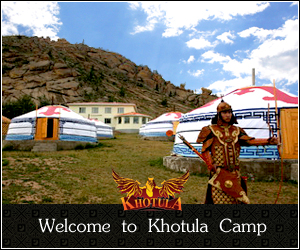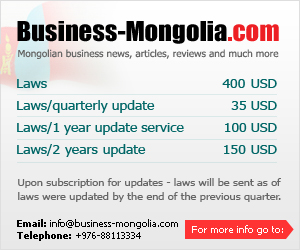Museums in Ulaanbaatar
 Natural History Museum
Natural History Museum
This is definitely a place you do not want to miss out on visiting, you can actually touch all of the exhibits on show including a large meteorite sat in the middle of the floor and a Tyrannosaurus Rex fossil! The museum is very popular with school groups and most visitors to the country. The museum contains exhibits from Zoology, Geology, Botany, Anthropology and Paleontology.
There is also a museum on the third floor called the “Golden Camel” museum, exhibiting Camel paraphernalia from all over the country. The museum also includs fossils discovered by the American Paleontologist Robert Andrews Chapman during the 1920’s.
The main exhibits consist of a Tyrannosaurus Rex skeleton and the amazing “fighting Dinosaurs”, dinosaur eggs, not to mention a wide range of examples of the massive array of wildlife that’s wondering around Mongolia. There’s also an exhibit containing the first Mongolian Cosmonauts space suit and helmet.. All of which you can play with to your hearts content. Entry is around 2,000 – 3,000 Tugrik and most if not all museums charge around 5,000 for a photo pass, which is a little unfair and gets rather expensive if you want to visit all the museums.
Mongolia is the Dinosaur capital of the world and many new discoveries have been made here. Mongolia is rich in many mineral resources not only Gold and Copper but many that are used for medicinal purposes, the Natural History Museum is a must see for all the family.
The Natural History Museum is a large white palatial like building, which can be found just behind the National History Museum, located on Khuvisgalchdyn Orgon Choloo. Open Tuesday to Sunday 10.00 – 16.30 during the summer months.
 Intellectual museum (National Toy Museum)
Intellectual museum (National Toy Museum)
The toy museum is housed in a four storey building behind the UlaanBaatar Hotel and contains exhibits of over 500 toys and puzzles from around the world. The intellectual museum is popular with school parties and tourists alike. The museum is a great day out and there are loads of stuff to keep people occupied, ranging from more conventional games like chess and checkers to the more complete puzzles and brain teasers.
There’s also one puzzle in the museum that has a $100,000 USD grand prize attached to it, if you can crack it! … it maybe worth flying to Mongolia for this alone to some people! The museum is well laid out and sign posted so there shouldn’t be anyone getting lost either.
 Mongolia is the birthplace of chess, which is also a popular game with children and adults alike, and is still widely played among children and teenagers, you will find many people old and young playing chess in the open air during the summer months all over the city and the countryside sometimes going on for days!
Mongolia is the birthplace of chess, which is also a popular game with children and adults alike, and is still widely played among children and teenagers, you will find many people old and young playing chess in the open air during the summer months all over the city and the countryside sometimes going on for days!
Like many of the Museums in UB the museums run tours in English, Russian and Mongolian to cater for all. Admission is the normal 2,000 for adults and 1,000 for the sproggs.
Location: Baga Toiruu. Open 10.00 – 17.00 Monday – Saturday.
Bogd Khan’s Winter Palace
 The winter Palace was the home of the eight living Buddha and the last king of Mongolia. The Palace was built between 1893 and 1903. The Palace suffered at the hands of local thieves until they were caught by a guard a few years ago, while they were scraping gold leaf from the roof!
The winter Palace was the home of the eight living Buddha and the last king of Mongolia. The Palace was built between 1893 and 1903. The Palace suffered at the hands of local thieves until they were caught by a guard a few years ago, while they were scraping gold leaf from the roof!
The winter palace isn’t always open so you might have to pay more than one visit if you want to see the inside. The palace itself is located on the southern side of Peace Bridge and can be easily identifed by the colorfully painted building and that are visible from the road, I say this because there’s quite a large wall surrounding the Palace!
The Palace is home to the Bogd Khaan’s Ger which is made from the skins of no less than 150 snow Leopards! which is shocking to see in all kinds of ways. Other exhibits also include the Khan’s bedroom, throne and personal dwelling space and the picturesque tranquility of the well preserved buildings. There are a total of six temples situated within the Palace walls containing gifts from various Monarchs and Dignitaries from around the world.
Definitely worth a visit to see the grounds and the sheer antiquity of the palace itself. The best time to visit is during the summer months as the Palace is rarely open during the winter. The Palace was spared by the Russians who destroyed the Summer Palace instead!
The Palace contains lots of stuffed animals many of which were, members of the Khan’s personal Zoo! The Palace is also home to Mongolia’s declaration of independence from China.
Location: Chingisiin Orgon Choloo. Open Friday – Tuesday summer and winter (allegedly) 9.00 – 17.30 during the summer and 9.30 – 16.30 during the winter. Entry again is 2 – 3,000 Tugruk. There is a gift shop in the grounds.
 G.K.Jukov’s house museum
G.K.Jukov’s house museum
A decision has been taken to newly built G.K.Jukov House-Museum by a group of experts of the Ministry of Defense, the Russian Embassy in Ulaanbaatar, the General Headquarters of the Armed Forces of Mongolia, and the Military Museum.
The current house built in 1936 underwent a reconstruction in 1984.
Now, any reconstruction will not help the house. The new house-museum will be erected at 100% Russian investments by the “Russian house” company within two-months. The project has been designed by the Russian side.
Like the old building, the new one will have one floor and a mansard. The initiative is also supported by the Ministry of Defense of the Russian Federation.
Museum of Political Persecution
The museum is a wooden building with a large sloping roof and was once home to the late Prime Minister Genden, who was a victim of the purges carried out during the1930’s and was executed by firing squad in Moscow, under the orders of Joseph Stalin, for refusing the carry out the purges, in an attempt to crush counter revolutionaries. Ironically Genden was replaced by Anandyn Amar who suffered the same fate in 1941. The museum was opened in 1996 as a memorial to the 30,000 Mongolians, most of whom were Lamas, who died during the Russian occupation. Strangely many Mongolians are not even aware of it’s existence. The darker side of the Socialist occupation is often swept under the carpet in Mongolia, as many people do not like to admit that bad things ever happen here.
A number of Temples were destroyed and many Lama’s were executed during the socialist occupation. The Mongolian people were also banned from practicing Buddhism on pain of death. The people were also stopped from communicating with their extended family, which itself caused problems with childbirth, the infant mortality rate in Mongolia is still around 13% party due to this issue.
The Museum consists of the skeletons, of those who died at the hands of the Russians together with details of the methods used in the process and the tools of the trade. This is a little bit eary but non – the – less something that should be of interest to a nation, it would seem some habits Die hard in Mongolia!
Genden’s daughter was the original curator of the museum and records the tragic life of the many politicians and civilians that died during the purges, containing personal possessions and records of the victims.
Location: Genden Street (Gendengiin Gundamj) next to the Wedding Palace. Open Saturday to Monday 10.00 – 16.30 Photography T5,000, Video T10,000
Genden street, UB, Mongolia
Everyday 9am-7pm
324788 328547
[email protected] e-mail address is being
protected from spam bots, you need JavaScript enabled to view it Ticket: 2400 tug Video camera: 12000 tug Photo: 5500 tugriks














